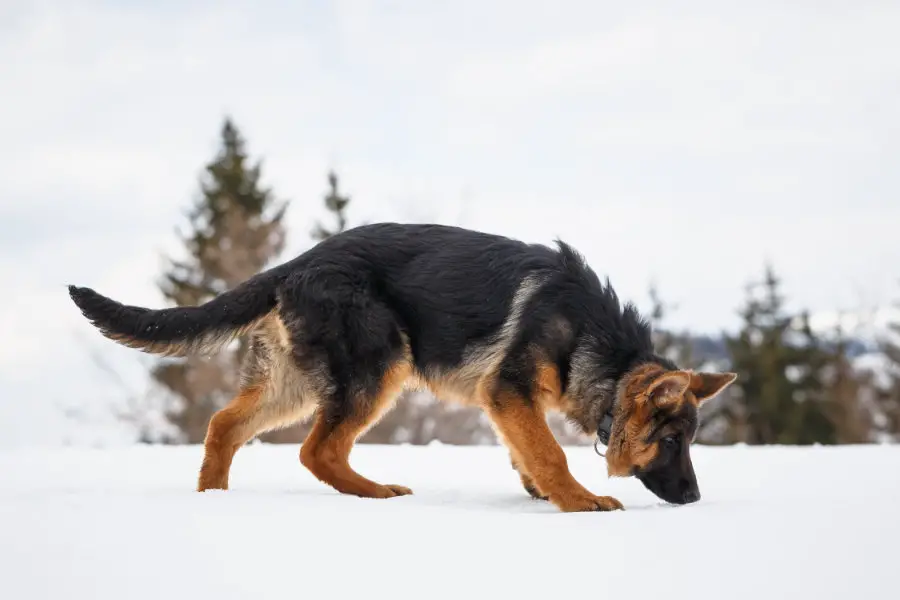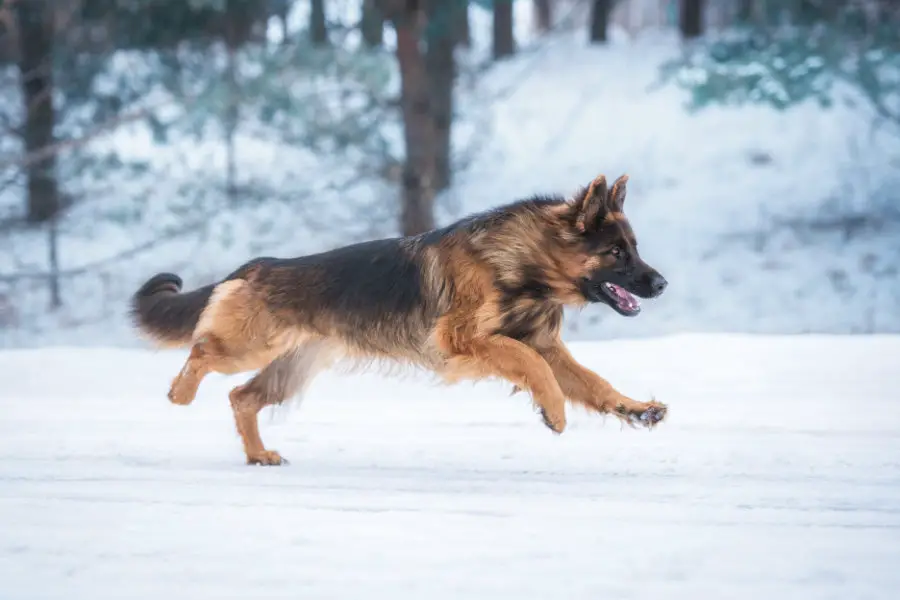A well-behaved, composed German Shepherd quickly abandons all dignity after a minor snowfall. They love the invigorating cold air and roll in the snow with pure joy, and it is a sight that brings a smile to the face of any dog lover. German Shepherds don’t mind the cold unless it’s too cold.
Most experts consider temperatures 20℉ or below to be too cold for a German Shepherd. But there are many variables that are individual for each German Shepherd, based on the dog’s size, coat, age, and health. If it’s too cold, your dog could develop hypothermia or frostbite.
As temperatures descend, you should limit the dog’s exposure to the outside. Let’s take a closer look at when it’s time to pull your buddy back inside.

How Do German Shepherds Tolerate Cold?
German Shepherd dogs are robust working dogs, and most have a double coat. The inner coat is furry and close to the body, so it acts as an insulator. The outer coat of hair repels moisture away from the dog’s body, preventing cold.
How much cold the German Shepherd can tolerate depends on which of three types of coat your dog has.
Some have only a very thin undercoat, with a short outer coat. Most fall into the medium category of a dense furry inner coat and medium-length outer coat.
Finally, others have a very thick inner coat for insulation, with a long protective outer coat.
It’s easy to guess which of the three can withstand the lowest temperature. The double coat works in reverse as well by keeping heat away from the skin in the summer. Some cold climate dogs need to be shaved to stay cool in summer but not the German Shepherd.
The bulk of the undercoat is shed in warm months and regrown when the cold weather returns. A German Shepherd should never be shaved, as his double coat protects him all year in all temperatures.
It’s essential that you know which of the three coat types your dog is so you’ll know how much cold he can tolerate.

Dogs Have Natural Heaters In Their Paws
Have you ever wondered how dogs can walk on snow and ice without their feet freezing? A study showed they can because the arteries and veins in the paws work like a heat exchanger. Blood arrives in the footpad, and before it cools, it enters into venules to keep it warm before pumping back through the dog’s arteries.
Dogs don’t often get frostbite, but it could happen. So careful monitoring of your dog’s paws during cold weather will protect against frostbite.
The Contributing Factors To Your German Shepherds Cold Tolerance
German Shepherds, as a breed, are equipped by nature to withstand cold and snowing weather. However, the degree to which they are fit for the cold is more personal.
For instance, German Shepherds are tall, so their bodies don’t make contact with snow, cold water, or the cold ground. But just because they have a bulky coat and warm circulation in their paws, that’s no guarantee your dog will enjoy cold weather and snow.
If your dog has arthritis or is older, he may feel discomfort in the cold sooner. Likewise, puppies don’t have the proper body weight and thick coats to protect against cold.
As humans, we can relate. Just because we can tolerate cold temperatures doesn’t mean we like it, which is also true for German Shepherds. Watch your dog closely in cold weather, so you can see when he has reached his tolerance level.
Even during cold months your dog still needs daily exercise and stimulation, so try to get him outside, even if it’s just for a few minutes.
German Shepherds Are Cold Weather Dogs
German Shepherds are counted as one of the best dog breeds that adapt well to cold climates.
Other breeds in the cold weather group include:
- Saint Bernard
- The Great Pyrenees
- Keeshond
- Komondor
- Siberian Husky
- Newfoundland
- Shiba Inu
- Norwegian Elkhound
The Siberian Husky dogs have been bred and conditioned to thrive in freezing climates.

How To Know When It’s Too Cold For Your German Shepherd
The first sign that it is too cold for your dog might be your own shivering. Common sense tells you that if it’s too cold for you to step outside, don’t send your dog out unattended.
Dogs cannot withstand extreme temperatures, any more than humans can. Hypothermia can result from being out in cold weather or cold water too long, and if the dog’s temperature drops, their organs will shut down, and will require professional treatment inmediately.
Some signs of hypothermia to watch for:
- Shivering, increased metabolic rate,
- Increased cardiac output, heat seeking,
- Decreased heart rate, decreased respiratory rate,
- Weak pulse and muscle stiffness
Bring the dog inside and warm him at the first sign of being too cold, then, call the vet right away. If the dog is wet, dry him well with warm towels. Then, wrap him in blankets and follow the vet’s directions.
Final Thoughts
German Shepherds are uniquely equipped to work in cold weather. The more energy the dog generates, the longer he can withstand the cold. How cold is too cold can only be determined by the dog and you.
We have provided basic temperature guidelines and symptoms that would indicate the dangerous temperature levels for your dog.
As the German Shepherd owner, you will undoubtedly notice when your dog is uncomfortable. Keep and eye out and call your vet when necessary.
